Today’s Guess the Artefact! covers one of a set of artefacts which are often found confusing to recognise. We often get questions about these artefacts, from students and teachers alike, so here’s a chance to test your skills of observation. Remember – all heritage and archaeological material is covered by State or Federal legislation and should never be removed from its context. If possible, photograph the find in its context and then report it to your local museum or State Heritage body (the Dept of Environment and Heritage Protection in Qld; the Office of Environment and Heritage in NSW; the Dept of Environment, Planning and Sustainable Development in ACT; Heritage Victoria; the Dept of Environment, Water and Natural Resources in South Australia; the State Heritage Office in WA and the Heritage Council – Dept of Tourism and Culture in NT).
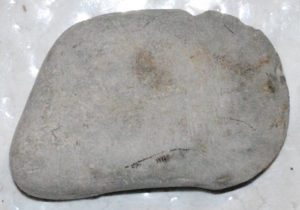
This artefact is made of stone. It measures about 12 x 8 x 3 cm. It fits easily and comfortably into an adult’s hand. The surface of the stone is mostly smooth and rounded, it looks a little like a river cobble. However, one side – the right-hand side in the photo above – is shaped so that 2 smooth sides meet in a straight, sharpish edge. Such formations do not occur on naturally rounded stones, which tells us that this was shaped by people and not just rounded in a river. The smoothed edges meeting in a sharp edge tell us that this is ground-stone technology. Ground stone technology is a technique used by people to create smooth, sharp edges on stones. People grind the stone against other rocks, occasionally using sand and water to facilitate the process, usually in a single direction. This forms a smooth surface which ends in a sharp edge.

Ground stone technology is usually associated with the Neolithic period in Europe and Asia. In the northern hemisphere, this technology was primarily used by people who were learning to domesticate plants and animals. These early farmers learned to grind grains, such as wheat and barley, between two stones to make flour – thus breaking down the structure of the plant and making it easier to digest. Our modern mortar and pestle is a descendant of this process. Early farmers would have noticed that these actions produced smooth and sharp edges on the stones. These observations would have led them to apply this technique to other tools which they used and thus develop the ground-stone technology. Here (picture on right) we can see an Egyptian ground stone axe from the Neolithic period. The toolmaker has chosen an attractive red and white stone to make this axe-head.
In Japan this technology is much older than elsewhere in the northern hemisphere, and ground-stone axes have been found dating to 30,000 years ago during the Japanese Palaeolithic period. Until recently these were thought to be the oldest examples of ground-stone technology in the world. However, in 2016, Australian archaeologists Peter Hiscock, Sue O’Connor, Jane Balme and Tim Maloney reported in an article in the journal Australian Archaeology, the finding of a tiny flake of stone (just over 1 cm long and 1/2 cm wide) from a ground stone axe in layers dated to 44,000 to 49,000 years ago at the site of Carpenter’s Gap in the Kimberley region of north-west Australia. This tiny flake of stone – easily missed by anyone not paying close attention – is an excellent example of the extreme importance of ‘archaeological context’. Archaeological material that remains in its original context (known as in situ) can be dated accurately and associated with other material from the same layers, thus allowing us to understand more about the material. Anything removed from the context usually can not be dated and only very limited information can be learnt.
The find from the Kimberley makes Australia the oldest place in the world to have ground-stone technology. The tiny chip of stone, broken off a larger ground-stone artefact, probably an axe, was made by the ancestors of Aboriginal people in the millennia after they arrived on this continent. These early Australians did not practise agriculture, but they did eat various grains, which they leaned to grind between stones to make flour. It is possible that whilst processing these grains they learned to grind stone tools as well. Our artefact, shown above, is undated. It was found, totally removed from its original context, stored under an old house in Brisbane. The artefact is useful as a teaching aid, allowing students to touch and hold a ground-stone axe made by Aboriginal people in Australia’s past. However, since it was removed from its original context at some point, we do not know how old it is, or even where it came from exactly.
Our artefact is a stone tool. Specifically, it is a ground stone axe, made using technology that dates back almost 50,000 years in Australia! These axes were usually made by rubbing a hard stone cobble against rocks by the side of a creek. Water from the creek was used as a lubricant, and often sand was added as an extra abrasive. The making of ground-stone axes often left long grooves in these rocks. These are called ‘grinding grooves’ and can still be found near some creeks in the landscape today, such as in Kuringai Chase National Park in Sydney. The ground-stone axes were usually hafted using sticks and lashings of plant fibre, to produce a tool that could be used for cutting vegetation or other uses. Other stone tools look different to the one shown above, especially those made by flaking stone; however, smooth stones should always be carefully examined in case they are also ground-stone artefacts and not just simple stones!



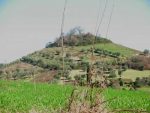 Students in years 5 and 6 in particular enjoy the
Students in years 5 and 6 in particular enjoy the 
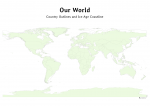 Adding events to a timeline, or the class calendar, also good ways to practise core skills.
Adding events to a timeline, or the class calendar, also good ways to practise core skills. This week we are starting into the last stretch of the term. Students are well into their final sections of work. Our youngest students are thinking about how we care for places, slightly older students are displaying their posters and older students are giving their presentations.
This week we are starting into the last stretch of the term. Students are well into their final sections of work. Our youngest students are thinking about how we care for places, slightly older students are displaying their posters and older students are giving their presentations. Students in Years 3 (
Students in Years 3 (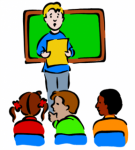 This week students are starting to round off their main body of assessable work for the term. Older students are completing and starting to present their presentations, while younger students have posters and models to finish off.
This week students are starting to round off their main body of assessable work for the term. Older students are completing and starting to present their presentations, while younger students have posters and models to finish off. Students in integrated Foundation/Prep/Kindy and Year 1 classes (
Students in integrated Foundation/Prep/Kindy and Year 1 classes ( Students in Year 3 (
Students in Year 3 (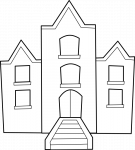 Foundation/Prep/Kindy to Year 3
Foundation/Prep/Kindy to Year 3 Students in Years 3 to 6 are continuing with their project on an explorer. Students in Year 3 (
Students in Years 3 to 6 are continuing with their project on an explorer. Students in Year 3 (
My grade 4 son's review is below. I think he liked seeing the patterns it made. It was just a…
Brad